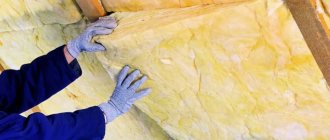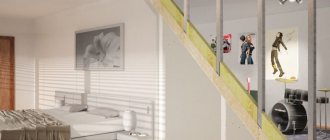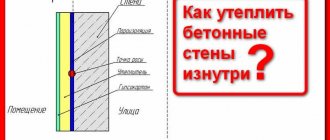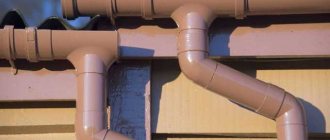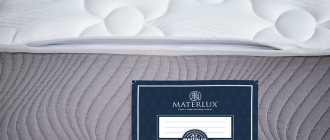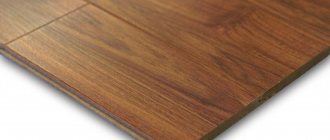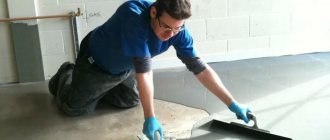Many owners of country and country houses, in order to increase their living space, equip an attic space to create an office, bedroom, or living room there. Such a room is usually called an attic. It needs to be insulated.
Attic insulation scheme.
Several different materials are used as insulation: mineral and glass wool, polystyrene foam, polyurethane foam, and other insulation materials. But not all of these materials are suitable for carrying out work on thermal insulation of an attic space for converting it into a real attic.
Requirements for insulation for attic roofs
Insulation is used for different purposes, therefore the requirements for it differ. The material used for certain work must cope with its task as completely as possible. The attic roof layout is complex. Here it is necessary to insulate the slopes, gables, ceiling and floor. Each element is distinguished by its design complexity, and for thermal insulation to be effective, it must meet the following requirements:
- Fire safety is the first requirement. At a minimum, the insulation should not support combustion. Maximum if the material does not burn at all.
- Good sound insulation will eliminate the penetration of extraneous noise from the street. First of all, this concerns the impact of hail and raindrops on the roofing.
- Good vapor permeability will eliminate the formation of dampness. A favorable microclimate will be established on the top floor of the attic.
- Resistance to moisture is important since the attic roof is exposed to rain and snow.
- The environmental friendliness of the insulation ensures safe living for people.
Advice!
To make sure that the insulation meets all requirements, you must request a certificate from the seller before purchasing it. A complex attic layout requires insulation of the floor, slopes, pediment and ceiling. Taking into account the listed requirements for an attic roof, the best insulation is considered to be the one that retains heat to the maximum. After all, it is used for these purposes. Since in the attic it is necessary to thermally insulate the roof slopes, floor, ceiling, and gables, the question arises: is it possible to use one material for all areas. In fact, there really is such insulation labeled “Universal”. If this designation is on the package, then the thermal insulation is suitable for any roof components.
What is better: polystyrene foam or polyurethane foam?
Ecotermix 600 is the best material for insulating an attic from the inside!
In conclusion, it should be noted that using polyurethane foam as insulation can save more than 20% of the heat that the house previously lost. Moreover, polyurethane foam allows you to hide all defects of the surface on which it is applied. In the absence of seams, heat losses will be minimized, and the use of a centralized ventilation and air conditioning system will ensure that the attic space will always be ventilated and will not be hot there in the summer.
As a result, answering the question: is it possible to insulate an attic with polystyrene foam, it should be noted that this method undoubtedly represents the most cost-effective insulation option, i.e. is optimal when insulation work needs to be completed as quickly as possible at the lowest cost. But to achieve the best result, it is recommended to use polyurethane foam spraying technology. Thus, the overall thermal insulation of the attic will be performed at the highest level!
Insulation thickness in the attic roof
Thermal insulation is sold in different thicknesses for a reason. How well the material will cope with its responsibilities depends on this parameter. You cannot apply insulation at random. If there is insufficient thickness, the roof will freeze, and excess layers will lead to unnecessary expenses.
Each type of insulation has a different thermal conductivity coefficient
There is such an indicator as the thermal conductivity coefficient: λB – W/(m*°C). Each insulation has its own meaning. Mineral wool or glass wool is usually laid on the attic roof. It is important to take into account that as the thickness increases, the thermal conductivity coefficient also increases. An example parameter is shown in the table:
However, there is another factor that influences the choice of thickness - the climate of the region. To select a suitable material for the roof, you need to calculate the heat transfer resistance of the roof (R – m2*0C/W). Only specialists can make accurate calculations. An ordinary developer can take the data from the table, which shows major cities in different regions.
Knowing the heat transfer resistance of the roof and the thermal conductivity coefficient of the insulation, calculate its thickness for the attic roof using the formula: R* λB
Mineral wool
Using mineral wool will perfectly protect the room not only from cold or excessive heat, but also from noise. However, the disadvantage of the material is its high hygroscopicity, which necessitates the use of a waterproofing layer to increase moisture resistance.
When creating a thermal insulation layer for the roof, the thickness of the insulation for the attic can vary in the range of 15 - 20 - 25 cm, which depends on the structural features of the rafter system. In order for the mineral wool to fill the required space, the width of the canvas should be 2 cm larger.
Thanks to the use of thermal insulation, sufficient conservation of comfortable heat, breathability, and eco-cleanliness of the internal layers without the development of fungus, mold, and microbes will be ensured in the attic.
Insulation density for attic roofing
An equally important parameter of thermal insulation is its density. If you take the attic, then there are areas that are and are not subject to heavy mechanical load. The first group includes gender. If the top floor of the attic is residential, then furniture and household appliances are placed here, and people walk around. Insulation needs high density.
The minimum thermal insulation density for the attic is 35 kg/m3
The second group includes roof slopes and other structural elements. The mechanical load on the insulation here is small, but you also need to take into account the angle of inclination. For pitched roofs, it is customary to use thermal insulation with a density of 25 to 45 kg/m3. It is for the attic roof that this value should be higher than 35 kg/m3.
Basic insulation technologies
It is very difficult to install the material without joints and cracks
When insulating an attic with polystyrene foam, it is important to remember that it is best to use slabs 100-150 mm thick. This will increase the thermal insulation qualities of the room and make it favorable for living. It is best to lay polystyrene foam in several layers, alternating them with offset joint seams. Particular attention must be paid to the roof. This is due to the fact that it is through it that the main heat losses of the attic occur.
In general, the whole process is conditionally divided into 2 stages: insulation of the roof and walls. When insulating walls, it is necessary to take into account that they are lined with slabs on all sides: inside and outside.
This video about insulating an attic with polystyrene foam shows how builders cut slabs of material - naturally, due to the uneven edges, it will not be possible to avoid joints and cracks. The material will allow heat and cold to pass through.
What kind of insulation is best to insulate an attic roof?
The most common materials for roofing are mineral wool and glass wool, but there are other insulation materials. Sometimes it makes sense to use them. The choice of material depends on the stage at which the roof is insulated, the type of rafter system, roofing and other nuances.
Mineral insulation
Mineral materials open the rating of insulation for attic roofs. Outwardly, they resemble cotton wool. Release form: rolls or slabs.
Glass wool does not contain organic matter
Glass wool is considered budget-friendly. The material consists of glass fibers, holds heat well, but is afraid of dampness. The second disadvantage is fast tracking. If the roof finish is not sealed, fibers can penetrate into the attic, causing allergic reactions. However, there are also advantages. Glass wool does not burn. Rodents cannot grow in the thorny substance.
Important! After laying the glass wool, the clothes will have to be thrown away, since it is almost impossible to wash them from the prickly fibers.
Popular brands of mineral wool are Isover and Ursa
Mineral wool is an analogue of glass wool, only there is a small percentage of glass fibers. The insulation is dominated by synthetic fibers and other additives. The multilayer structure retains heat well, but allows oxygen to pass through, which is especially important for the attic. The roof is warm and breathable. Rodents similarly do not like to build their burrows here. Mineral wool is resistant to open fire, but also caking and is afraid of moisture. The most famous manufacturers are Izover and Ursa. Mineral wool has special air lenses, which increase sound insulation properties.
Basalt insulation consists of natural stone fibers
Basalt wool does not have the property of pricking, causing body irritation or allergic reactions. The insulation is made from natural stone fibers obtained by melting it. The material is resistant to open fire, allows oxygen to pass through, and is non-toxic. Due to the absence of prickly fibers, rodents like to live in basalt slabs, but the likelihood of them appearing on the attic roof is zero.
Important! Basalt wool does not tend to cake and “breathes” throughout its service life.
Polymer insulation
There are attic roofs built with mistakes. One of them is the lack of waterproofing under the roofing. You can't use cotton wool here. Even the presence of a metal roof also creates problems due to the increased formation of condensation. Under such conditions, it is optimal to insulate the attic roof of a private house with polymer materials. Thermal insulation is completely resistant to moisture, does not require vapor barrier, but has one drawback. Polymers do not allow air to pass through. The attic roof loses its ability to “breathe”. The use of any polymer insulation requires ventilation in the attic.
Polyurethane foam is applied by spraying
Foamed polyurethane has all the parameters of an ideal insulation material. The foam is applied under pressure using special equipment. The liquid substance fills all voids and firmly adheres to the roofing material of the roof. Condensation and mold do not form under polyurethane foam. There is no possibility of cold bridges forming on the roof. The disadvantage is the high cost of the work and the need to hire specialists with equipment. When repairing the roof, the frozen foam will only have to be peeled off.
Expanded polystyrene and foam plastic are laid on flat areas without bends
Expanded polystyrene and polystyrene boards are difficult to lay if the attic has a broken rafter system. The material is inflexible. As for polystyrene foam, it is rarely used for the attic. The insulation burns, emitting acrid smoke. Polystyrene foam crumbles and has poor resistance to mechanical loads. Foam boards are suitable for insulating the attic gable when using the “wet facade” method. The insulation is hidden under several layers of plaster, which protects it from destruction and fire.
It is better to lay expanded polystyrene on the roof slopes, floor, and ceiling of the attic. The boards are highly durable and resistant to moisture. There is no need to lay a waterproofing and vapor barrier membrane. Expanded polystyrene is less fire hazardous, but is still afraid of fire.
Natural insulation materials
This group includes thermal insulation materials based on natural fibers. To improve performance characteristics, antiseptics are added. Fire retardants are additionally added to ecowool. Substances reduce the flammability of natural fiber. The advantage of insulation is its environmental friendliness. In all other respects, it loses to artificial materials. Rodents love natural raw materials; they absorb moisture, but after drying they restore their properties.
Wool felt has the same insulation coefficient as basalt wool
Wool insulation is more often found in the form of felt slabs. In the Caucasus, they use pure wool for roofs, placing it in bags inside the roofing pie. In both options, the material requires reliable vapor and waterproofing. Insects and rodents live in wool. For the attic, felt slabs are optimally used when arranging the floor. It is better not to lay wool on roof slopes.
Ecowool is applied using special equipment
Ecowool is considered an environmentally friendly material. It is made from waste paper products. Additives improve performance characteristics. Ecowool is suitable for roof insulation, but you will have to hire a specialized team with equipment. High costs do not make natural materials popular.
Covering with hexotextile and gravel
Geotextile material is laid on top of foam boards.
Thanks to this type of textile, the following main problems can be solved:
- protect the roof from the negative effects of solar radiation;
- reduce the effect of mechanical loads;
- increase the service life of the roof.
After the geotextile, a 5-centimeter layer of gravel is backfilled, the fraction of which is 16/32. The thickness of the layer, depending on the strength of the wind, may be less. Instead of gravel, paving slabs or concrete can be used, but a gravel layer is a more profitable option. This is explained by the need to carry out complex activities if you plan to lay paving slabs or work with concrete, and gravel can simply be filled in.
Advice from professionals
It is optimal to lay expanded polystyrene slabs when the roof is still under construction. If the attic has already been built, mineral materials are used. A sheathing is created on the inside. Mineral wool is placed between the rafters and covered with cladding on top.
Roofing pie, where any type of mineral wool is used as insulation, includes protective membranes from moisture
The use of any wool requires the installation of vapor and waterproofing. Membranes protect thermal insulation from moisture. The roofing pie consists of the following layers:
- on the roofing side of the roof, waterproofing comes first;
- thermal insulation is laid as a second layer;
- third layer – vapor barrier;
- to form a ventilation gap and fasten the internal lining, a sheathing is assembled from slats;
- the last layer is the finishing layer.
The ventilation gap is left at least 3 cm. Any materials you like are used for finishing: lining, plywood, particle boards.
Criterias of choice
Insulating an attic is a much more complex process than insulating floors, walls, windows and basements.
What matters here is the specificity of the sloping roof, which usually forms the attic, and the presence of sheathing - the insulation must be laid between the rafters and behind them, securely fixed and not change shape for a long time, despite the vertical location, it should not move away and sag.
It is also necessary to insulate the walls, ceilings, floors, gables - a fairly rigid material with good insulating properties is required.
If you choose between expanded polystyrene, polystyrene foam and mineral wool, you should choose the latter. Despite its higher cost, mineral wool has a whole range of useful properties that are superior to other heat-insulating materials.
It is environmentally friendly, retains its shape better than polystyrene foam and polystyrene foam, is not afraid of mice, unlike polystyrene foam, and unlike polystyrene foam, it is better ventilated and allows you to efficiently insulate the room, taking into account the need to live in it in the summer.
Installation of a waterproofing barrier
To eliminate the risk of moisture condensation on the inside of rafters and wall structures when using polystyrene foam, the first step is to install a waterproofing barrier
. The rolled material (film or membrane) must be laid in such a way that it envelops the rafters and adheres to the back side of the sheathing. It can be secured with staples using a construction stapler, but double-sided tape can also be used.
The waterproofing layer must be a single piece without seams. If you have to join pieces of film or membrane, you need to make an overlap of at least 15 cm wide and carefully glue the joints with reinforced tape.
Installation of a waterproofing barrier
If the end walls of the attic (gables) are made of timber or building blocks, you must choose one of two installation options
:
- the waterproofing film is attached using double-sided tape to a flat wall surface, after which the sheet heat insulator will need to be secured with nails with umbrella heads;
- a sheathing of bars is mounted on the walls, the width of which is equal to the thickness of the selected insulation, and a waterproofing barrier is attached on top of them according to the same principle as on top of the rafters.
In the case when polystyrene foam is chosen as a heat insulator, there is no special need for waterproofing - the insulation will not allow moisture from the room to pass through to wooden structures if you take care of the tightness of the seams when laying the insulation.
Some important recommendations
It is not difficult to properly insulate a roof from the inside, but before you begin, you should pay attention to the following points:
- using mineral wool or slabs as insulation, you need to take care of high-quality waterproofing of the roof;
- If damage was discovered during the preparation of the roof surface, it must be eliminated. If this is an attic, then it will have to be fully checked for functionality in order to avoid large investments in repairs in the future;
- It would be correct to check the electrical wiring, pipes, heating and water supply risers;
- if it is planned to insulate the roof from the inside with mineral wool materials, then they cannot be compressed during installation;
- It is also not recommended to bend the insulating material. In places of bending, the material will acquire the ability to absorb moisture.
Video description
Should you trust online calculators, watch the video:
The calculator helps estimate the cost of work Source www.strojmag.ua
Using the calculator, you can calculate the number of bricks for masonry, the cost of finishing, the dependence of insulation consumption on the width of the material, and many other parameters.
It is important to remember that the calculator does not provide exact numbers that can be used when designing or purchasing materials. It only helps to understand the principle of calculations and determine how much the same work will cost using different materials or projects. Full construction calculations can only be performed by qualified specialists.
Technological processing techniques
Foam insulation is easily machined. They are easily cut using a hand tool (hacksaw or construction knife). Thick sheets of expanded polystyrene can be cut using an electric jigsaw.
In cases where the final finishing involves applying a layer of plaster, the surface of the extruded polystyrene foam is processed using a needle roller. In this way, the surface is given the roughness necessary for strong adhesion to the plaster.
When using polystyrene foam, such an operation is not performed. The surface already has sufficient roughness.
Calculation example
Let's calculate how much mineral wool is needed for a gable symmetrical roof with seven rafter intervals 60 cm wide and a slope length of 5 m. at the same time, the dimensions of the slab are 1.17x61x25cm.
First, we determine the number of slabs in one row: 5/1.17 = 4.27 pcs.
We multiply the result by the number of steps (7): 4.27x7 = 29.89 slabs will be needed for one slope and 59.78 for the entire roof. It is better to round the resulting result up, that is, 30 and 60 pieces, respectively.
Mineral wool Source haikudeck.com


